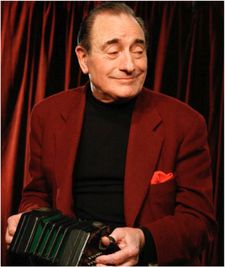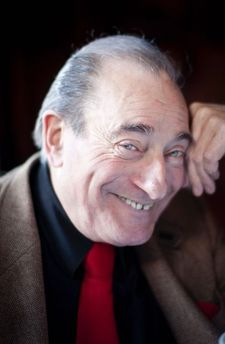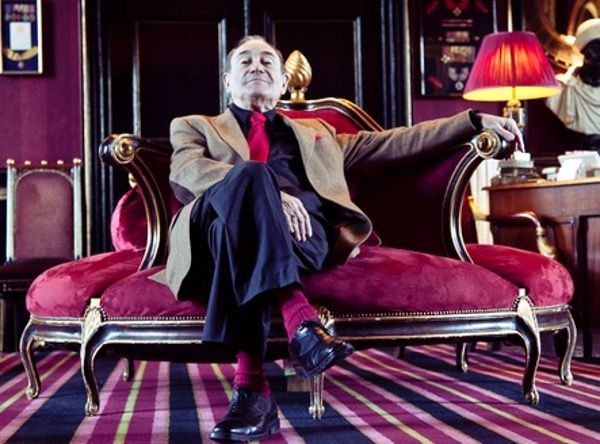As an actor, assistant director and gag writer, Pierre Étaix worked with everyone from Jacques Tati to Jerry Lewis. If you had to sum up his life in a single word, “clown” is the one that first comes to mind.
Étaix’s work in the circus, in music-hall, in film, his writings and in his visual imagery all testify to his being a worthy heir to a long clowning tradition which he has successfully transmuted into his films, just as his predecessors did in their time.
Discovering clowns at the age of five, seduced by the circus world, and the comic films of Stan Laurel and Oliver Hardy, Charlie Chaplin and Harold Lloyd, Pierre Étaix has, essentially, built his career around this theme. Not being a child of the theatre, nonetheless he prepared for his craft as a comic by studying violin, piano, accordion, and creating his characters of the august clown and music-hall eccentric, inspired by the clowns Rhum, Bario, Zavatta and Charlie Rivel.
His training as an illustrator and painter is evident in his pictorial work, his artful sense of composition, alongside his ability to construct comic narrative and the purely cinematic gag. But he didn’t stop there: in his teens he taught himself conjuring, saxophone, trumpet, concertina and mandolin. At 16, he made his debut as an august clown, under the name of Paro, alongside a musician and gymnast partner.
At 17, he joined an amateur theatre troupe and performed in local revues, and over a five year period took part in shows for which he wrote sketches and built sets. He also performed musical numbers, pantomime, magic tricks, lightning caricature sketches, as well as working on the entrance of clowns into the ring.
During this time he also earned a living as an illustrator for the publisher Hachette, and the magazines Le Rire and Fou rire. In September 1954, taking advantage of a trip to Paris to deliver drawings to some magazines, Étaix requested an interview with Tati to ask his advice on a new number he wanted to present in both the circus and the music-hall. His humorous drawings caught the attention of the filmmaker, with whom he subsequently spent almost four years working as a gagman and illustrator during pre-production on the film Mon Oncle.
 |
| Pierre Etaix, who has died at age 87 Photo: Laurent Koffel |
In 1958, he illustrated the novel Les Vacances de Monsieur Hulot, written by Jean-Claude Carrière. That same year he met Robert Bresson at Tati’s production offices, who asked him to play the part of second assistant to the magician Kassagi in his film Pickpocket. The following year he illustrated the book Mon Oncle, also written by Carrière.
On the advice of cinematographer Jean Bourgouin who Pierre Étaix had met during the shooting of Mon Oncle, Dolivet, the producer at Gray Film, suggested that Étaix write and direct a short film: Le Petit Citoyen. The project, shot in the studio, remained only in test form: with only six minutes edited. Étaix then decided to write and direct another short film in 8mm, to which he gave the same title, again working closely with Carrière.
At the end of 1959, Pierre Étaix discovered the clown Charlie Rivel who was performing in the Medrano circus. Dazzled by the comic impact of this eccentric clown, he met him at the end of the show. And thus began a steadfast friendship.
“What struck me about Charlie, was the child within him. In performance he reproduced everything a kid can come up with, full of spontaneity and impudence.”
In 1960, Tati and Bruno Coquatrix asked Étaix to perform his eccentric mandolin number in the show Jour de fète á l’Olympia. The success of the number led producer Paul Claudon to seek a meeting with Étaix and persuade him to come up with some short film ideas. His apprenticeship with Tati made it feel quite natural for him to direct his first short film, Rupture, co-scripted with Carrière.
The day after shooting the film, which was released as La Guerre Des Boutons, Étaix presented his producer with an idea for his second short film Heureux Anniversaire which he co-directed with Carrière. The film won the Oscar for Best Short in 1963, alongside many other awards. Despite this recognition, the producer had some reservations about making a feature-length film. So Étaix decided with Carrière to write the further adventures of the comic character from the two previous films as a series of shorts.
He told one interviewer: “Carrière and I quite simply wanted to tell the story of an awkward guy who doesn’t know how to approach girls. As Claudon was reluctant to produce a feature, we said: Let’s make a film out of sequences that would work as so many short films in their own right. The way it was with Laurel and Hardy’s Our Wife.”
Claudon finally agreed to produce a feature film, having found a way to raise the money. The little scenarios were incorporated into the very structure of the film, which gave it a very particular flavour. Le Soupirant (1963) won the Louis Delluc prize. Once again, with Carrière, Pierre Étaix wrote and directed his second feature film Yo Yo (1964), and then Tant Qu’on A La Santé (1965).
Next on the agenda was Le Grand Amour (1968), then, during the summer of 1969, Pays de cocagne which was shot on Super 16mm, a film for which he was condemned by the film industry and the critics who found it hard to forgive this melancholy account of the development of the consumer society in the aftermath of May 68. Étaix then returned to his initial vocation and in 1971 toured for a season with the Pinder circus as a clown, performing in the ring as an august and as a (whiteface) clown, with Annie Fratellini who was now his wife.
 |
| Six years ago many of his key films reappeared in restored versions in cinemas and on DVD. Photo: Laurent Koffel |
During the 1980s, he appeared in various films while in 1989 he directed J’écris Dans l’Espace, co-written with Carrière and filmed in Omnimax, an early form of 3D. It was with this last film that Étaix’s film career came to a halt, leaving his desire to make two cherished mid-length films, co-written with Carrière, unfulfilled.
However he did publish several books of writings and drawings. He accepted a role in Otar Iosseliani’s film Jardins en automne (2006) and in the same filmmaker’s next film Chantrapas.
Jean-Pierre Jeunet paid tribute to him by asking him to play the inventor of funny stories in Micmacs (2009). At the end of January 2010, he returned to the stage in Bordeaux with his new music-hall show Miousik Papillon, in which, combining music and slapstick, he reappeared, after a 40 year absence, as Yoyo.
Six years ago many of his key films reappeared in restored versions in cinemas and on DVD. For those unaware of his existence, these screen gems of the 1960s provided a happy discovery; for those who knew him, a cause for celebration. Restored under the joint supervision of two cultural heritage bodies (Groupama Gan Foundation and Technicolor Foundation for Cinema Heritage), the revived interest in his work gave Étaix a whole new lease on life.
Richard Mowe is director of French Film Festival UK/Odile Étaix is Pierre Étaix’s widow.
Étaix at a glance
1928: Birth in Roanne.
1954: Met Jaques Tati.
1958-61: Pierre Étaix performs in different cabarets and music-halls. 1958: Illustrations for the book, Les Vacances de Monsieur Hulot, written by Carrière.
1961: Directed his first short, Rupture.
1963: Oscar for best short to Heureux Anniversaire.
1963-1970: Étaix directed five features: Le Soupirant, Yoyo, Tant Qu’on A La Santé, Le Grand Amour and Pays de Cocagne.
1971: Toured with the Cirque Pinder et Annie Fratellini.
1973: Founded the Ecole Nationale de Cirque with Annie Fratellini.
1985: Wrote his first play L’Age de Monsieur est avancé and acts in Nagisa Oshima’s film, Max mon Amour.
1989: Directed his first Omnimax fiction film, J’écris Dans l’Espace.
2001: Published several albums of texts and drawings.
2006: Acted in Otar Iosseliani’s Jardins en Automne.
2009: Published Textes et Textes-Étaix and acts in Jean-Pierre Jeunet’s Micmacs.
2010: Actor for Otar Iosseliani (Chantrapas) and Aki Kaurismäki (Le Havre).
2010: Tribute at French Film Festival UK






















